Rules for listing companies
Since users rarely visit this page unless they want or have requested some kind of project expansion, I did not want to repeat concepts to describe inclusion or exclusion of companies in the coal mining specialty separately. Without getting overly pedantic and repetitive, I hope users will please substitute the words "coal" and "coal companies" for "railroad" and "railroad companies" below, remebering that the purpose of this project is about cataloging collectible certificates issued by raiload and coal companies, not other specialties.
Over 28,000 genuine rail-related companies are currently listed in this project. They are represented by over 24,000 different varieties and sub-varieties of collectible stocks, bonds, and closely-related documents. I also list over 2,000 companies in the coal mining specialty. Like railroads, coal mining companies in North America have been tremendously numerous. Unlike railroads, though, I do not catalog coal companies until certificates appear. As of early 2025, that includes over 2,800 certificates and that number grows continuously.
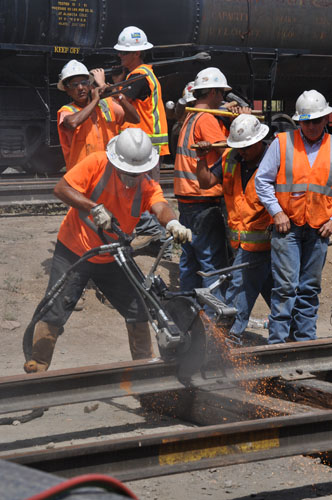
Even with that huge number of collecting possibilities, collectors frequently ask me to include companies not directly related to railroads and the carriage of passengers and freight. I fully understand their desires. After all, most collections include certificates other than railroads and collectors want to see some of their favorite certificates listed in a hobby catalog.
Limiting project expansion beyond railroads
Experience has proven that I must refrain from expanding the project beyond the bounds of railroading. My decisions about which companies to include or ignore are not capricious. Decisions about coal company inclusions are essentially the same, with only a few differences, land control probably being the largest exception.
Whereas coal companies needed large expanses of land for extraction, railroads needed narrow strips. Coal companies tended to either own their land or lease land under specific terms, whereas railroads generally controlled rights-of-ways acquired under land grants, imminent domain, or long term leases. In both cases, those companies frequently dealt with "land companies." Often, land issues were managed separately their own separately incorporated land companies. Because land companies were equally as numerous as railroad and coal companies, I must consider land companies off topic for this project.
Users of this site may not agree, but limitations are absolutely necessary to avoid getting "burned-out" and keeping this project going. The two most compelling reasons for preventing further expansion include:
- Practicality: Railroading was the largest business in the 19th century. Railroads touched every major North America industry and mst of those industries touched railroading. Those inter-dependencies are not sufficient reason to classify other types of businesses as railroads. I suggest a simple test of logic. "Would collectors of certificates in a different industry think of looking for their certificates in a catalog dedicated to railroad certificates?"
- Time commitment into the future: The innocent addition of a single certificate from an off-topic industry creates numerous problems. First, every off-topic certificate added requires I must track its sales forever into the future. If the issuing company is not clearly related to railroading, auction catalogs will probably not list such companies among railroads. Finding them takes time I'd rather spend on-topic.
- Time commitment recording past sales: If I include a new certificate loosely related to railroading, I must re-examine many hundreds of previous auction catalogs page by page, lot by lot to find and record past sale appearances. Were I to list a single off-topic certificate for all to see, I would quickly receive requests from other collectors to include certificates from similar companies. In short, requests for further expansions would never stop.
On- and off-topic company groups
These links will take you to specific sections (below) for more detailed explanation:
The ground rules
This page is a collection of guidelines used to decide whether certificates from non-railroads deserve inclusion or not. The basic bounds of this project encompass companies that:
- intended to carry freight and/or passengers over rails for profit
- manufactured rolling stock, crucial equipment, and crucial parts for railroads
- provided services that railroads did not want to do themselves
- played major roles in building and financing railroads
The basic ideas extend to coal companies. Did the company:
- mine or intend to mine coal for sale
It is sometimes difficult to determine whether companies existed merely for the resale of coal. Since it is overly time-consuming to investigate company histories, certificates from coal resellers are catalogued along with coal producers. Railroads frequently mined coal for their own uses, normally under subsidiaries. In those cases, subsidiaries and their operating agreements are often unknown. Generally speaking, if a company sounds like a coal mining company, then it is usually included in this project. If it sounds like a land company, utility, or some other kind of company, it is not.
Avoiding dissension
I fully appreciate that collecting is 100% personal. I want to make it perfectly clear that I am NOT telling a single person how or what to collect. I have loose collections in many topics unrelated to railroads or certificates. Still, my main pursuit in this project is collecting and organizing information about stocks and bonds issued by railroads and coal companies. I do not expect anyone to see that pursuit the same way as me. Moreover,
I do not claim to be fully consistent. My professional experience is in economic geology in the coal and minerals business. Geology and economics are highly ambiguous endeavors. Every decision, every prediction, and every conclusion is subject to disagreement and revision. Nothing in that industry is "carved in stone." This project is no different. Even the classification of certain collectible securities is open to interpretation. I am comfortable with ambiguity and lay out these project rules with the full knowledge that some of my "rules" may seem inconsistent to others. I expect differing opinions. I expect almost everyone to take exception to several of my decisions about the types of companies I choose to list or exclude. I do not take those disagreements personally.
Companies that moved freight and passengers for hire
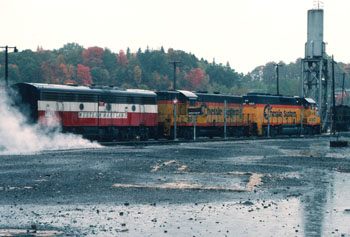
These are GENUINE RAILROAD COMPANIES. These companies are the primary sources for certificates in our hobby. They are the main focus of this project. If there were a single characteristic that identified railroad companies, it would be that they intended to sell transportation across rails. For the purposes of this project, those companies need to have operated or planned to operate in North America.
These are companies that even the most casual of observers would call railroad companies. They were incorporated to carry passengers and freight produced by unrelated companies, on a fee basis, from points of departure to different points of destination.
Information sources for railroad company names are highly variable in quality, accuracy, and content. It is not always possible to discriminate between officially-incorporated companies and those that operated under private ownership. Both types are listed here even though the issuance of stock was limited to officially-incorporated companies.
| Company type |
Listed |
Listed with explanation |
Listed only if railroad keyword present |
Listed if positively rail-related |
Not listed |
| typical railroad - incorporated |
x |
|
|
|
|
| typical railroad - unincorporated |
x |
|
|
|
|
| transit or transportation company |
|
|
|
x |
|
| depot railroad |
x |
|
|
|
|
| terminal railway |
x |
|
|
|
|
| street railway |
x |
|
|
|
|
| elevated railroad |
x |
|
|
|
|
| interurban railroad |
x |
|
|
|
|
| inclined railway |
x |
|
|
|
|
| subway |
x |
|
|
|
|
| monorail |
|
|
|
x |
|
| national railroad |
x |
|
|
|
|
| municipal, regional and state railroad |
x |
|
|
|
|
| water shipping and transport |
|
|
x |
|
|
| airport |
|
|
|
|
x |
| trucking |
|
|
|
|
x |
| bus transportation |
|
|
|
|
x |
| company with operations outside North America |
|
|
|
|
x |
back to top
Companies that moved their own goods and products
Companies in this group did NOT generate income from railroading. The companies made money by selling products, not transportation. They may have moved freight or passengers by rail, but transportation over rails was ancillary to their main business purposes. Rail operations were private and captive to parent companies. They were never considered common carriers.
In general, none of these companies will be cataloged unless they indicated rail involvement by rail-related keywords in their corporate names.
| Company type |
Listed |
Listed with explanation |
Listed only if railroad keyword present |
Listed if positively rail-related |
Not listed |
| plantation |
|
|
x |
|
|
| logging, timber |
|
|
x |
|
|
| mining, quarry |
|
|
x |
|
|
| steel |
|
|
x |
|
|
| other industry |
|
|
x |
|
|
back to top
Entertainment-based rail transportation

Several amusement parks installed miniature railroad equipment and often named them like legitimate railroads. A few of them are listed in this project, with appropriate explanation, but only to decrease confusion with genuine railroads.
A few amusement parks went a bit further and installed full-scale equipment for visitor entertainment. While certainly intended to carry passengers for profit, those rail operations did not operate offsite. They are not listed in this project because their names are usually sufficient to indicate they were not full-fledged railroads. Moreover, they normally operated on closed loops.
Dinner trains and tourist trains are found across the continent, and for liability reasons, are normally incorporated. While entertainment and pleasure are by-products of transportation, some of these companies are classified as common carriers and some take passengers to destinations different than their points of origin. Although they are somewhat hybrid entities, this project classifies specific types of entertainment railroad companies among legitimate railroads for cataloging purposes.
| Company type |
Listed |
Listed with explanation |
Listed only if railroad keyword present |
Listed if positively rail-related |
Not listed |
| amusement park |
|
|
|
|
x |
| miniature, or incline railroad |
|
x |
|
|
|
| roller coaster |
|
|
|
|
x |
| tourist railroad |
x |
|
|
|
|
| dinner train |
x |
|
|
|
back to top
Holding companies
Holding companies are corporate structures that make money from the profits of the companies they own. Most of the largest railroad companies on the continent operated as parts of larger holding companies. In most cases, those larger holding companies had names that identified closely with one or more of their subsidiary railroads.
Some holding companies were small and worked under anonymous-sounding names. This project lists both types of holding companies as long as they made significant percentages of their profits through rail transport.
There were several highly-diversified holding companies that used railroads almost exclusively for company usage. It is possible some might have made meager profits from railroading, but this project ignores such companies.
For similar reasons, this project also ignores companies that made the bulk of their profits from real estate, mineral resources, and other industries. Finally, this project also ignores companies whose primary purpose was to hold, sell, or lease patents, even if those patents were rail-related.
| Company type |
Listed |
Listed with explanation |
Listed only if railroad keyword present |
Listed if positively rail-related |
Not listed |
| to hold railroad companies |
x |
|
|
|
|
| to hold railroad equipment |
x |
|
|
|
|
| to hold land and real estate, development |
|
|
|
|
x |
| to hold mineral resources |
|
|
|
|
x |
| to hold patents |
|
|
|
|
x |
| to hold other industries |
|
|
|
|
x |
back to top
Companies directly involved with railroad infrastructure
Several companies built or operated properties crucial to railroad infrastructure. Some of those companies could be considered among other collecting specialties, but they are listed here when they are clearly related to railroading.
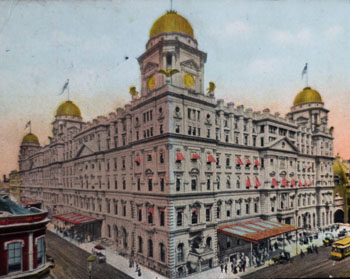
The most obvious connections to railroading are companies that built or operated large structures like union stations and large depots. As a general rule, small stations were owned by single railroad companies. Large stations in large cities, and even large switchyards, were often owned jointly by several large railroads. This project lists both types of companies.
Most real estate-related ventures are not cataloged in this project. For instance railroads often owned grain elevators, stockyards, and warehouses but those endeavors were simply temporary storage sites for freight. I recognize that large stock yards such as those in Chicago and Kansas City contributed mightily to railroad profits through fees charged for handling live freight. Nonetheless, stock yards were normally separate businesses. This project considers stockyards as either a separate industry type or one closely related to the cattle industry.
Terminal companies are listed in this project when they had clear relationships with railroads and preferably used rail-related keywords in their company names. The majority of terminals benefitted from rail service into their facilities, but that doesn't mean the terminals themselves were all rail-related. Many served the purpose of inter-industry shipping. Large numbers of terminals and wharves operated for the benefit of canal, river, lake, and ocean shipping. Terminals are included when there is positive proof of significant involvement of railroad companies. Mere ownership of track and switches, or even switching locomotives, within terminals is not necessarily reason for inclusion.
Tunnel companies were very much businesses separate from railroading. They allowed railroads to shorten routes by boring holes through hills and mountains. In practice, tunnel companies made money by leasing their tunnels to railroad companies or charging usage-based fees (also known as wheelage.) They profited by leasing or giving access to underground rights-of-way, not by selling transportation. Tunnel companies are ignored unless there is no compelling evidence that they produced income by hauling freight or passengers under their own names.

Using similar principles, bridge companies made money building and leasing rights-of-way across valleys, lakes, and bays. Like tunnels, bridges were crucial infrastructure and made money by charging tolls. Some bridge companies owned track and even operated switching equipment. Bridge companies will be included in this project when there is compelling evidence that they provided active services to railroads (like switching), provided transportation of some kind, or were otherwise linked to railroads through ownership of terminals and stations.
Bridge companies have always created problems. I polled users several years ago and discovered they wanted me to list bridge companies along with railroads. I complied for about a decade and, in hindsight, that might have been a mistake. There was a problem, invisible to collectors, in determining which bridge companies, out of hundreds, were actually rail-related. It's the old problem of drawing lines. "If you include one bridge company, why can't you include all?"
Even if relenting to include "some" bridge companies, I needed to determine how they were related to railroads and the extent of of the relationship in terms of income, ownership, and duration. That determination took research and the time consumption only increased with with each passing year. There was also the question of whether bridge companies were really on-topic or not.
Bluntly put, bridge companies were, and remain, bridge companies, not railroads.
Taking a softer approach, I decided I would list a sub-set of bridge companies in this railroad project IF AND ONLY IF bridge company relationships to railroading were indicated by wording of their corporate names. Therefore, I will include bridge companies if their corporate names contain words like "Railroad," "Railway," and certain other rail-specific keywords. I will not allow exceptions, even among companies I collect. Simply put, one exception always breeds more.
Most railroads hired separate construction companies to grade land, lay ties and track and ballast. Some railroad construction companies made tremendous profits for their stockholders and, without them, some railroads would never have been built. The two most famous construction companies, Credit Mobilier and Contract & Finance, never even mentioned the word "railroad" in their names. This projects lists railroad construction companies as long as there is positive and easy-to-find proof of their involvement in railroading.
Terminal companies are treated similarly. Many terminals benefitted from railroad service, but made almost all their profits by transshipping freight for canal, river, lake, or ocean shipping. As explained above, terminals are included when there is positive proof of significant relationships to railroading.
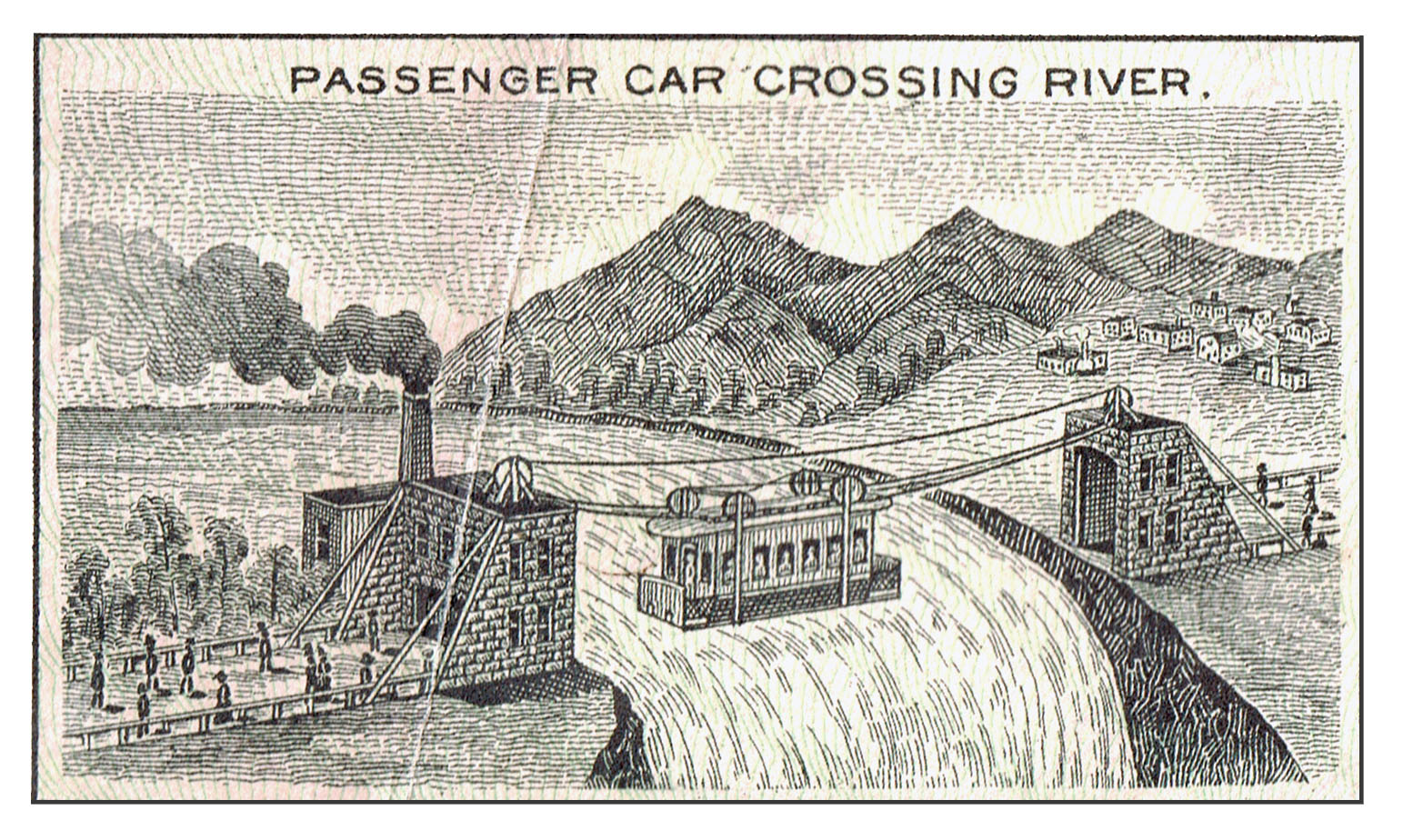 |
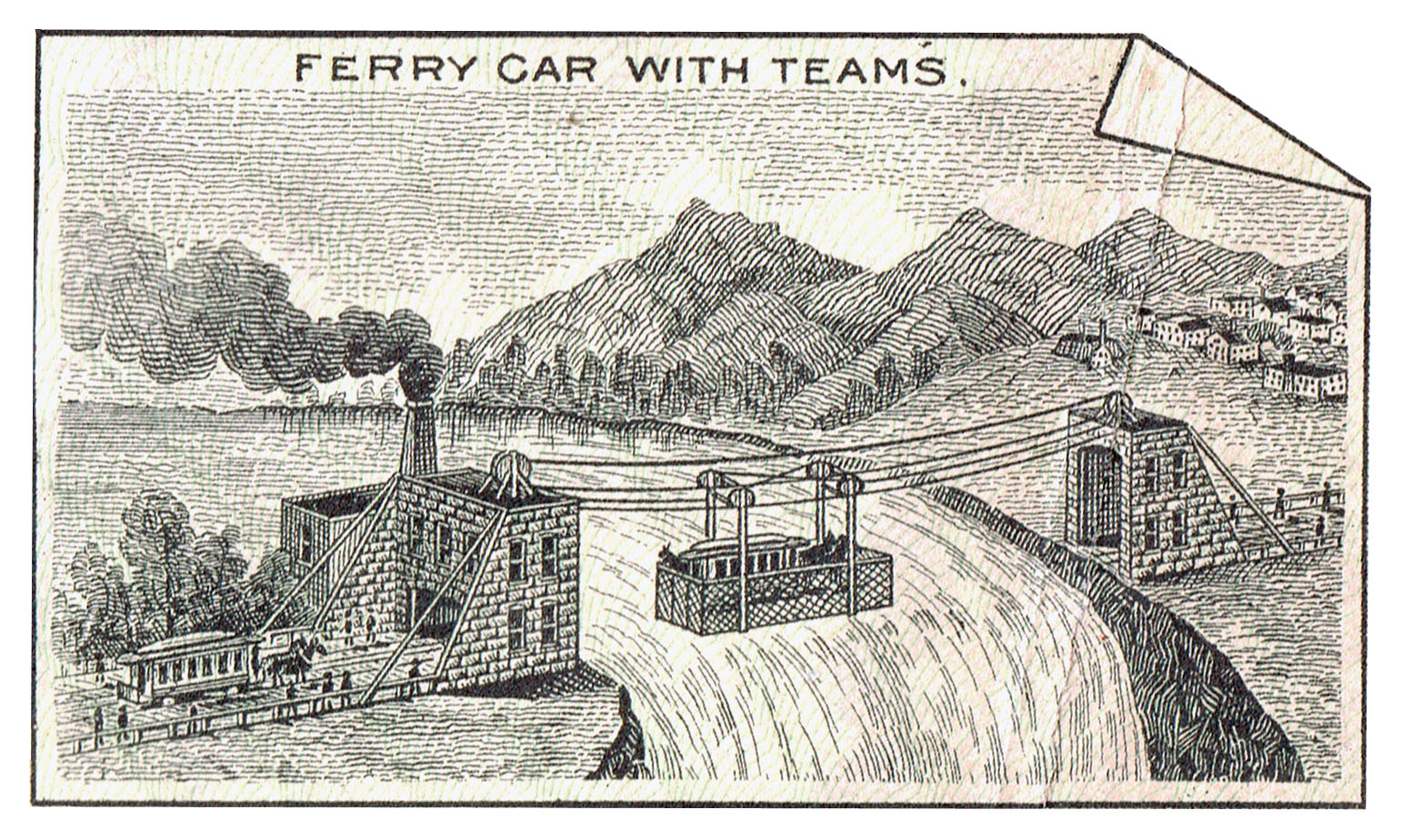 |
Two lithograph vignettes by the Meyercord Co. These appear on certificates of the Chicago-based Gagnier-Griffin Suspended Railway Bridge Company, Incorporated. A more elaborate depiction of the left image appears in the June 16, 1894 issue of American Engineer & Railroad Journal (v68, pp 282-283.) In 1894, one of the company's bridges was used by the Unakaa Park Company to cross the Tennessee River at Knoxville, from the terminus of the West End Railway across a span of 1,060 feet. The description in the Journal does not say whether the bridge actually carried any railway cars or not. No other references are known that indicate whether the company installed any of its bridges elsewhere. This company is catalogued because it clearly carries indication of its 'railway' purpose in is name.
| Company type |
Listed |
Listed with explanation |
Listed only if railroad keyword present |
Listed if positively rail-related |
Not listed |
| bridge |
|
|
x |
|
|
| tunnel |
|
|
x |
|
|
| construction |
|
|
|
x |
|
| terminal |
|
|
|
x |
|
| depot |
x |
|
|
|
|
| station |
x |
|
|
|
|
| warehousing |
|
|
|
|
x |
| stock yard |
|
|
x |
|
back to top
Companies sometimes associated with railroading
It would be difficult to list all the kinds of companies that have used, owned, or otherwise been associated with railroads. Nonetheless, only a few qualify for listing in this project.
This project will list those companies that had such solid relationships with railroading that they included rail-related keywords in their names. Among those companies may be banks, chemical manufacturers, docks, wharves, ferries, foundries, and utilities.
Some companies are simply too far removed from the actual movement of freight and passengers to be included, even if they included a railroad-related keyword in their names. Such companies frequently include diversified companies, express companies, grain elevators, roads, turnpikes, schools, and toy companies (e.g. Tyco and Lionel.)
Power generation companies are a special group of sometimes-related companies. They are discussed in more detail at utilities are not railroads. While some evolved from humble beginnings as horse railways, utilities are listed here ONLY when they display rail-related keywords in their names.
| Company type |
Listed |
Listed with explanation |
Listed only if railroad keyword present |
Listed if positively rail-related |
Not listed |
| bank |
|
|
x |
|
|
| chemicals |
|
|
x |
|
|
| diversified (with incidental rail use) |
|
|
|
|
x |
| docks and wharf |
|
|
x |
|
|
| express company (unrelated to railroading) |
|
|
|
|
x |
| ferry |
|
|
x |
|
|
| foundry |
|
|
x |
|
|
| grain elevator |
|
|
|
|
x |
| real estate |
|
|
|
|
x |
| road, turnpike |
|
|
|
|
x |
| school |
|
|
|
|
x |
| toy manufacturer |
|
|
|
|
x |
| utility |
|
|
x |
|
|
| utility that owned or leased rolling stock |
|
|
x |
|
|
| other miscellaneous |
|
|
|
|
x |
back to top
Companies involved in railroad services
Numbers of different companies offered services TO railroad companies. Perhaps the most important, and worthy of listing in this project, are equipment leasing companies, particularly companies that provided rolling stock (tank cars, chemical cars, gondolas, etc.). Included in that group are equipment trusts and they are listed as a separate branch of bonds.
There were several express companies that worked as intermediaries, shipping goods via railroads, trucks, ships, and airlines. This project lists only those companies that used rail-related keywords in their names.
A bit harder to uncover are companies that were (are) related rather directly to railroads, but did not disclose that fact in their names. These include companies that provided repairs and services to railroad infrastructure, equipment suppliers, and special ferry services for rail cars. Those kinds of service and supply providers are hard to find. They are listed in this project when rail relationships are positively confirmed.
This project ignores companies that never contributed directly to railroad operations or provided support for crucial railroad infrastructure. Such exclusions include companies involved in advertising, promotions, consulting, food services, printing, publishing, and retail products. The project also excludes suppliers of crucial consumable commodities such as oil, coal, diesel fuel, and water.
| Company type |
Listed |
Listed with explanation |
Listed only if railroad keyword present |
Listed if positively rail-related |
Not listed |
| advertising and promotional services |
|
|
|
|
x |
| communications (telegraph, microwave) |
|
|
|
|
x |
| consulting |
|
|
|
|
x |
| consumable commodity supplier - fuel |
|
|
|
|
x |
| consumable commodity supplier - water |
|
|
|
|
x |
| railroad equipment leasing company |
x |
|
|
|
|
| equipment supplier |
|
|
|
x |
|
| food service |
|
|
|
|
x |
| railroad infrastructure service and repair |
|
|
|
x |
|
| printing, publishing |
|
|
|
|
x |
| railway express service |
|
|
x |
|
|
| retail products |
|
|
|
|
x |
| water-borne transfer of rail equipment |
|
|
|
x |
back to top
Equipment manufacturers - primary mobile equipment
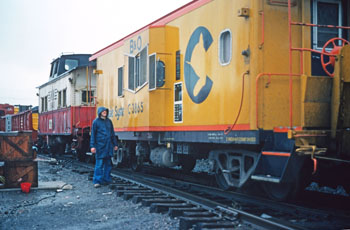
This project lists manufacturers of locomotives and primary rolling stock, regardless of whether they are known to have incorporated or not. If a company's equipment could have been seen in motion along any line in North America, from Panama to Canada, it will be listed here. This category covers all rolling stock, from locomotives to cabooses and everything in between. It also includes certain secondary equipment such as man cars, hand cars, and so forth.
| Company type |
Listed |
Listed with explanation |
Listed only if railroad keyword present |
Listed if positively rail-related |
Not listed |
| locomotive builder |
x |
|
|
|
|
| rolling stock builder |
x |
|
|
|
back to top
Equipment manufacturers - primary fixed infrastructure

These companies produced crucial, non-mobile equipment that supported railroad company infrastructure. Ancillary structures were commonly used in the open air and subject to environmental and physical damage. This equipment was highly important to railroads and subject to continual maintenance, repair, and replacement.
| Company type |
Listed |
Listed with explanation |
Listed only if railroad keyword present |
Listed if positively rail-related |
Not listed |
| ties |
x |
|
|
|
|
| spikes |
x |
|
|
|
|
| switches |
x |
|
|
|
|
| frogs |
x |
|
|
|
|
| signals |
x |
|
|
|
|
| semaphore |
x |
|
|
|
|
| crossing equipment |
|
|
|
x |
|
| crossing gates |
x |
|
|
|
|
| rail (steel, iron, other) |
|
|
|
x |
|
| rail joints |
x |
|
|
|
|
| rail chairs |
x |
|
|
|
|
| track braces |
x |
|
|
|
back to top
Equipment manufacturers - secondary parts and equipment

Practically every part that makes up every piece of railroad infrastructure needs to be replaced at some point. Rolling stock and locomotives are subject to constant wear, tear, and breakage. They need parts constantly. The number of manufacturers of secondary railroad parts is huge.
Roughly half the manufacturers of such crucial equipment indicated their involvement in railroading by their corporate names. Most used terms easily associated with railroading and no other industry.
The remainder are listed if positive relationships to railroading can be found. Words such as axle, bearings, springs, wheel, and brake shoes indicated products important to railroading, but were used heavily by any number of other industries. Certain railroad keywords do not always guarantee listing in this project.
| Company type |
Listed |
Listed with explanation |
Listed only if railroad keyword present |
Listed if positively rail-related |
Not listed |
| axles |
|
|
|
x |
|
| bearings |
|
|
|
x |
|
| bolsters |
x |
|
|
|
|
| brake beams |
x |
|
|
|
|
| brake shoes |
|
|
|
|
x |
| brake systems |
|
|
|
x |
|
| car boxes |
x |
|
|
|
|
| car doors |
|
|
|
x |
|
| car fenders |
|
|
|
x |
|
| car gates |
x |
|
|
|
|
| car heaters |
|
|
|
x |
|
| car lighting |
|
|
|
x |
|
| car locks |
|
|
|
x |
|
| car motors |
|
|
|
x |
|
| car platforms |
x |
|
|
|
|
| car roofing |
|
|
|
x |
|
| car seals |
|
|
|
x |
|
| car seats |
|
|
|
x |
|
| car springs |
|
|
|
x |
|
| car starter |
x |
|
|
|
|
| car trucks |
|
|
|
x |
|
| car ventilation |
|
|
|
x |
|
| clocks, watches |
|
|
|
|
x |
| controls (in-cab) |
|
|
|
x |
|
| couplers |
|
|
|
x |
|
| draft gears |
x |
|
|
|
|
| fireboxes |
x |
|
|
|
|
| headlights |
|
|
|
x |
|
| indicators, in-cab, station, streetcar |
x |
|
|
|
|
| journal boxes |
x |
|
|
|
|
| mail devices, pouches, cranes |
|
|
|
x |
|
| non-specific, miscellaneous train equipment |
|
|
|
x |
|
| oiling equipment |
|
|
|
x |
|
| train pipe, pipe couplings |
|
|
|
x |
|
| refrigeration equipment |
|
|
|
x |
|
| safety equipment |
|
|
|
x |
|
| signal lanterns |
x |
|
|
|
|
| smoke separators and burners |
x |
|
|
|
|
| snow plows |
x |
|
|
|
|
| spark preventive devices |
x |
|
|
|
|
| superheaters |
x |
|
|
|
|
| ticket registers |
x |
|
|
|
|
| train controllers |
x |
|
|
|
|
| train stops |
x |
|
|
|
|
| wheels |
|
|
|
x |
|
| wheel dogs |
x |
|
|
|
back to top
Railroad financing
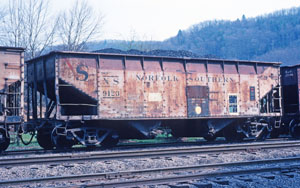
No railroad company could have existed without financing. Companies found much of the money they needed through selling stock and borrowing money through bonds. Without financing, few companies could have lasted from grading to opening day.
Significant external funding came from bonds floated by towns, cities, counties, states and countries. This project calls such bonds aid bonds. Of equal, if not of greater importance were equipment trusts. that allowed companies to procure the exact equipment they needed and could pay back through rental fees. Equipment trusts usually lasted 15 years, approximately the life span of most rolling stock. This project lists all those kinds of rail-related financing entities.
Excluded are ordinary government bonds that did not directly benefit railroading.
| Company type |
Listed |
Listed with explanation |
Listed only if railroad keyword present |
Listed if positively rail-related |
Not listed |
| car trusts |
x |
|
|
|
|
| railroad equipment trusts |
x |
|
|
|
|
| aid bonds (to aid specific company) |
x |
|
|
|
|
| municipal bonds (to fund city railway) |
x |
|
|
|
|
| state bonds (to fund state railway) |
x |
|
|
|
|
| government bonds unrelated to railroading |
|
|
|
|
x |
| government bonds for abolition of railroad crossings |
|
|
|
|
x |
back to top
Railroad investment associations
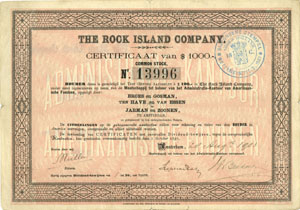
This project lists a select group of unincorporated, non-governmental associations involved in railroad financing. Principal among listings are protective associations (aka "committees") formed in Holland on behalf of Dutch investors in North American railroads. I recommend the book, Slow Train to Paradise: how Dutch investment helped build American railroads (by Augustus Veenendaal, Jr.) to anyone unfamiliar with the importance of Dutch investments. Similar associations were formed in Great Britain, France, and Germany, although barely a handful of certificates have been seen in North America.
American bondholders also formed their own protective associations on occasion. Only a few are known, but all are listed in this project when their relationships to railroading are confirmed.
Similar associations or committees were formed when railroad companies were undergoing reorganization. Again, they are listed here because many issued special certificates that are now collectible.
| Company type |
Listed |
Listed with explanation |
Listed only if railroad keyword present |
Listed if positively rail-related |
Not listed |
| Dutch, English, French, German protective association |
x |
|
|
|
|
| bondholder association |
|
|
x |
|
|
| reorganization committee |
x |
|
|
|
back to top
Rail-related associations
A number of associations have been formed that related to railroading in some manner. The most obvious associations, and the ones listed in this project, are associations between operating railroads on some sort of local or regional basis. Most of those associations were never incorporated and never issued certificates, but ignoring them would cause their own problems when collectors find them listed in railroad literature.
There are, however, three major types of associations that are not listed in this project. Among them are labor unions and brotherhoods. These associations had members who worked for railroad companies, but employees are not operational companies.
A second and huge group are model railroad clubs. Many such clubs issued membership cards and even fantasy certificates that are now circulating among collectors. This project ignores all model-related clubs, train layouts and fantasy certificates.
Practically every collector has encountered railroad museums or historic parks somewhere in North America. Again, none contributed to the operational profits of railroads, so none are listed in this project.
| Company type |
Listed |
Listed with explanation |
Listed only if railroad keyword present |
Listed if positively rail-related |
Not listed |
| union, brotherhood |
|
|
|
|
x |
| railroad hobby model club |
|
|
|
|
x |
| rail-related park, museum, historical society |
|
|
|
|
x |
| railroad company associations (operational company) |
x |
|
|
|
back to top
Securities companies involved with railroad assets
There were a small handful of brokerages and fund companies that specialized in securities issued by railroad companies. Admittedly, those kinds of companies were unrelated to operational railroads and not really involved in any direct railroad financing. However, to reject them from listing in this project would create the never-ending necessity of explaining to collectors why they are not included.
Consequently, I will list any stock or bond fund that included rail-related keywords in its name.
| Company type |
Listed |
Listed with explanation |
Listed only if railroad keyword present |
Listed if positively rail-related |
Not listed |
| stock funds |
|
|
x |
|
|
| bond funds |
|
|
x |
|
|
| railroad funds and shares |
|
|
x |
|
back to top
Off-topic companies
This project does not catalog certificates from off-topic companies. Such companies are removed whenever they are located. Nonetheless, some off-topic companies remain in the database and throughout railroad literature. There is simply not enough time to research every company listed in this database and mistakes in published references will remain forever.
This is where every user of this database can help.
I am always looking for railroad companies that should be listed in this database and I am always looking for off-topic companies that should be removed. I maintain a list of companies that have been excluded.
| Company type |
Listed |
Listed with explanation |
Listed only if railroad keyword present |
Listed if positively rail-related |
Not listed |
| products or purposes that belong in industries other than railroading |
|
|
|
|
x |
back to top
Fictitious and fantasy companies
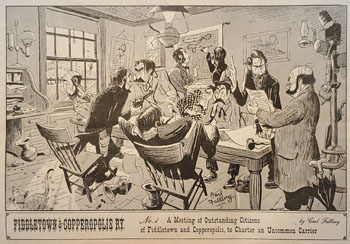
Some businesses have used fictitious company names for promotional purposes. While imitations of stocks and bonds are rare, numerous replicas of railroad passes have been seen and some sound completely legitimate. Although thankfully rare, fake company names have occasionally made it into the vast literature of railroading, which makes spotting them even more difficult.
A few museums and model railroad clubs produced certificates that resemble legitimate stocks and bonds and some have appeared occasionally on eBay and in professional auctions and dealer lists. None of these certificates would fool anyone in person, but they could easily deceive remote bidders on auction sites. Certificates like these are listed in this database to help collectors spot deceptions.
See a current listing of non-cataloged companies that have been rejected because they are off-topic or fictitious.
| Company type |
Listed |
Listed with explanation |
Listed only if railroad keyword present |
Listed if positively rail-related |
Not listed |
| names that sound rail-related |
|
x |
|
|
back to top